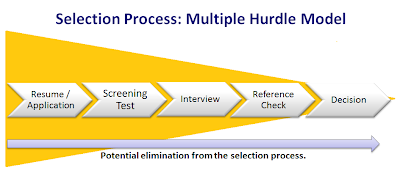This is the fourth in a 11 part series that looks at:
There are three main tools that help in organizing the selection process in an efficient and effective manner:- The Business Case
- Key Advantages of Competency-based Selection
- How Competencies Improve Selection
- Top 3 Features of Best Practice Recruitment and Selection - #1
- Top 3 Features of Best Practice Recruitment and Selection - #2
- Top 3 Features of Best Practice Recruitment and Selection - #3
- Common Tools: Job Postings & Behavioral Interviews
- Common Tools: Track Record Review and Reference Checks
- Common Tools: Standardized Tests, Part 1
- Common Tools: Standardized Tests, Part 2
- Tips for Implementing a Recruitment and Selection System
- The selection process work flow diagram
- The competency coverage grid, and
- The selection element weighting and rating grid.
Selection Process Flow: Multiple Hurdle Model
The diagram below shows a simple version of a multiple hurdle selection process. Each step represents a stage at which candidates can progress or be eliminated from the process, depending on whether they meet or do not meet the criteria being assessed at the particular selection stage. For example, the first stage in the sample shown in the diagram is the Resume / Application Screen. Criteria being assessed at this stage could include things like meeting certain minimum education or experience requirements. They could also include meeting certain competency requirements as evidenced either by experience or through recognized accomplishments or certifications (e.g., specific technical / professional competencies acquired through successful completion of a recognized educational program; certification in a certain discipline; etc.). The second stage in the selection process could include a test to assess technical or professional knowledge, aptitude, abilities, and so on.
The number and type of selection elements to be included in the Selection System will be determined by the complexity of the position, the number and type of the competencies to be assessed, as well as the suitability of the selection elements for assessing each competency. For example, oral communication skills can be more readily assessed through an interview than through a resume screen.
Finally, the sequence of the selection elements is typically organized for efficiency. For example, a group testing process typically is undertaken earlier in a selection process, because it normally takes less time and effort to process candidates and determine whether they meet the selection criteria being assessed. In-depth selection interviews, on the other hand, are more labor intensive and typically involve more senior level resources; therefore, they are normally completed later in the selection process after the candidate pool has been narrowed down.
The next two blogs discuss how competencies provide the foundation for the efficient and valid assessment of candidates for jobs using the “competency coverage grid” and “weighting and rating grid”.
The next blog in this series examines the second top feature of a best practice recruitment and selection program. Sign up to our blog’s mailing list through the form on the right-hand side to receive the rest of the series in your inbox.
HRSG is a leader in competency-based recruitment and selection solutions and training. Contact us today to find out how we can help you.
 Want to learn more? Download a Best Practice Guide to Improve the Effectiveness of your Interviewing Processes
Want to learn more? Download a Best Practice Guide to Improve the Effectiveness of your Interviewing Processes Compared to unstructured interview approaches, the behavioral interview approach greatly increases your chances of making the best selection decisions. Download this guide to learn how to interview candidates to gather critical information about candidates’ past performance and accomplishments that you can use to predict their performance and accomplishments in the job that you are filling.

No comments:
Post a Comment